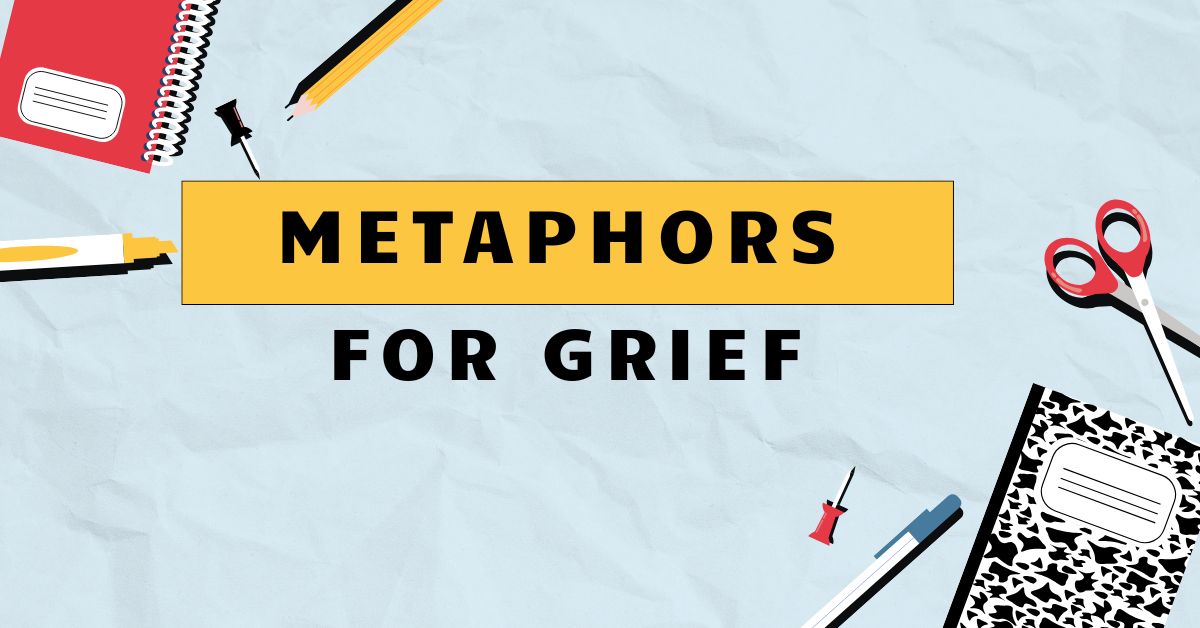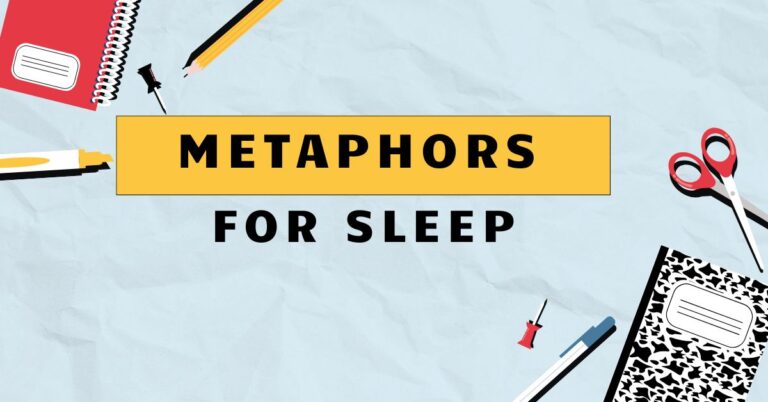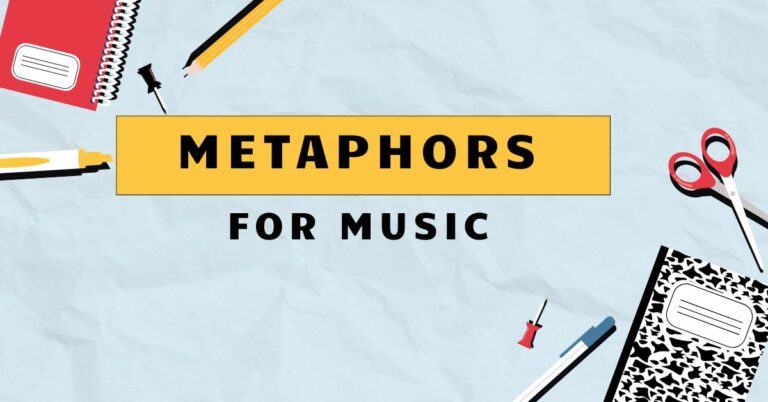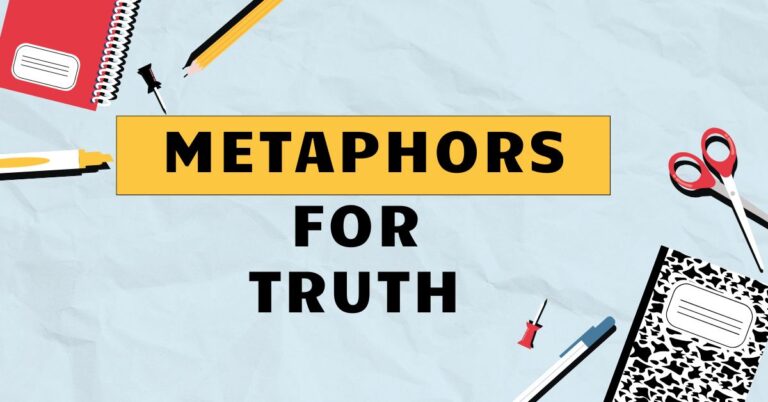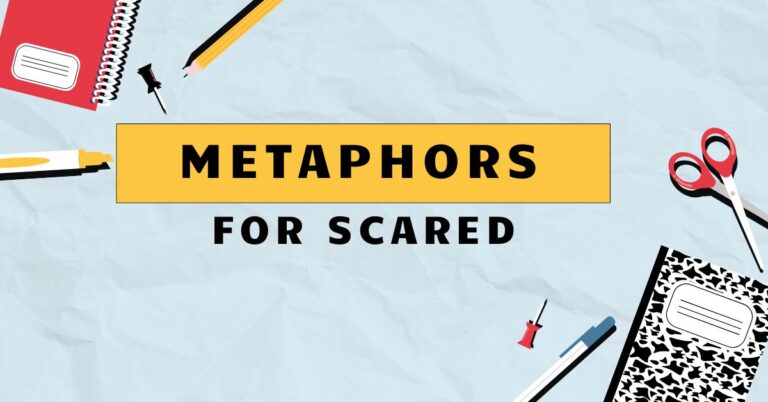29 Metaphors for Grief: Understanding Loss Through Figurative Language
Grief is a universal human experience, yet its depths can be incredibly difficult to articulate. We often turn to metaphors – figurative language that compares one thing to another – to help us understand and communicate the complex emotions associated with loss.
Understanding these metaphors not only enriches our comprehension of grief but also provides a powerful tool for empathy and connection. This article will explore the rich landscape of metaphors for grief, examining their structure, types, and usage.
This exploration is valuable for anyone seeking to better understand their own grief, support others through loss, or enhance their understanding of English language and literary expression. Students, counselors, writers, and anyone touched by grief will find this guide insightful and helpful.
Table of Contents
- Definition of Metaphors for Grief
- Structural Breakdown of Grief Metaphors
- Types of Metaphors for Grief
- Examples of Metaphors for Grief
- Usage Rules for Metaphors of Grief
- Common Mistakes Using Metaphors for Grief
- Practice Exercises
- Advanced Topics in Grief Metaphors
- Frequently Asked Questions
- Conclusion
Definition of Metaphors for Grief
Ametaphoris a figure of speech that directly compares two unlike things without using “like” or “as.” It asserts that one thing *is* another, implying a similarity or shared quality. In the context of grief, metaphors provide a way to express the inexpressible, to give form to the abstract and often overwhelming emotions associated with loss.
These metaphors function as powerful tools for understanding, communicating, and processing grief. They help us to make sense of the complex and often contradictory feelings that arise during bereavement.
The function of a metaphor for grief extends beyond mere description. It allows us to tap into shared human experiences and create a sense of connection with others who have also experienced loss.
By using figurative language, we can evoke empathy and understanding in a way that literal language often fails to do. The context in which these metaphors are used is crucial; cultural background, personal experiences, and the specific relationship with the deceased all influence the interpretation and impact of the metaphor.
Structural Breakdown of Grief Metaphors
Understanding the structure of metaphors is essential for appreciating their power and nuance. A typical metaphor consists of two main elements: thetenorand thevehicle.
The tenor is the subject being described (in this case, grief), and the vehicle is the object or concept used to describe the tenor (e.g., a storm, a burden). The vehicle carries the associated qualities that are then attributed to the tenor.
For example, in the metaphor “Grief is a heavy cloak,” the tenor is “grief,” and the vehicle is “a heavy cloak.” The qualities associated with a heavy cloak – weight, restriction, discomfort – are transferred to our understanding of grief. This structure allows us to grasp the feeling of grief as something burdensome and limiting.
The effectiveness of a metaphor also depends on theground, which refers to the shared characteristics between the tenor and the vehicle. The stronger the ground, the more resonant and understandable the metaphor will be.
In the example above, the ground lies in the shared experience of weight and restriction, making the metaphor relatable and meaningful.
Types of Metaphors for Grief
Grief is a complex emotion, and metaphors used to describe it are diverse. Here are some common categories:
Grief as a Burden
This is one of the most common metaphors for grief, portraying it as a heavy weight or load that one must carry. This metaphor emphasizes the emotional toll and the feeling of being weighed down by sadness and loss.
The idea of grief as a burden highlights the difficulty of moving forward and the constant effort required to cope with the pain.
Grief as a Storm
This metaphor captures the turbulent and overwhelming nature of grief. It emphasizes the unpredictable and destructive forces that can be unleashed by loss.
The storm metaphor often includes elements of chaos, confusion, and a sense of being tossed about by powerful emotions, like waves crashing against the shore. This can also signify the temporary nature of intense grieving periods.
Grief as an Absence
This metaphor focuses on the void or emptiness left by the deceased. It highlights the feeling of something missing or incomplete.
The absence metaphor is often used to describe the lingering pain and the constant awareness of the person who is no longer present. It emphasizes the profound impact of their absence on daily life and future plans.
Grief as a Journey
This metaphor frames grief as a process with stages, challenges, and eventual healing. It suggests that grief is not a static state but rather a dynamic and evolving experience.
The journey metaphor often includes elements of progress, setbacks, and the eventual arrival at a new destination or understanding. It acknowledges that the path through grief is unique to each individual.
Grief as Physical Pain
This metaphor links the emotional pain of grief to physical sensations, such as a stabbing pain in the heart or a deep ache in the body. It highlights the intense and visceral nature of grief, emphasizing its impact on physical well-being.
This metaphor helps to convey the profound and often debilitating effects of loss on both the mind and body.
Examples of Metaphors for Grief
The following tables provide a range of examples for each category of grief metaphors discussed above. Each example illustrates how the metaphor is used to convey the complex emotions associated with loss.
Table 1: Examples of Grief as a Burden
This table illustrates how grief is often depicted as a heavy weight or burden, emphasizing its draining and oppressive nature.
| Example | Explanation |
|---|---|
| Grief is a heavy backpack, always weighing me down. | The constant presence and weight of grief are emphasized. |
| The sorrow was a stone in my chest. | The physical sensation of heaviness represents the emotional burden. |
| I’m carrying the weight of the world on my shoulders since she passed. | The enormity of the loss is likened to an overwhelming burden. |
| His grief was a lead blanket, smothering his joy. | The oppressive nature of grief is highlighted. |
| She felt crushed under the mountain of her grief. | The overwhelming and insurmountable nature of grief is conveyed. |
| The burden of his absence is almost unbearable. | The constant awareness of the loss is a heavy weight to bear. |
| Grief is a heavy chain, binding me to the past. | The restrictive and limiting nature of grief is emphasized. |
| She carried her grief like a fragile vase, always afraid of dropping it. | The delicate and precious nature of grief is highlighted. |
| The weight of grief threatened to pull him under. | The overwhelming force of grief is depicted as a drowning sensation. |
| My heart feels like it’s carrying a ton of bricks. | The heavy emotional burden is directly compared to a physical weight. |
| Grief has become an anchor, holding me back from moving forward. | The feeling of being stuck in the past is emphasized. |
| The sadness is a heavy cloak I can’t seem to take off. | The constant presence and burden of grief are highlighted. |
| Each day, I lift the heavy weight of grief and try to carry on. | The daily effort required to cope with grief is emphasized. |
| His grief was a physical load, bending his back. | The physical toll of grief is highlighted. |
| The pain of her loss is a constant weight on my soul. | The enduring nature of grief is emphasized. |
| I feel like I’m dragging a ball and chain of grief behind me. | The restrictive and hindering nature of grief is conveyed. |
| The grief was a heavy fog, slowing his every step. | The impeding nature of grief is highlighted. |
| He bore his grief with stoic strength, but the weight was evident. | The hidden burden of grief is acknowledged. |
| My grief is a suitcase I carry everywhere, filled with memories. | The constant presence of grief, filled with memories, is emphasized. |
| The weight of their absence is almost too much to bear. | The difficulty of coping with the loss is highlighted. |
| Grief is a heavy stone in the pit of my stomach. | The physical manifestation of grief is emphasized. |
| She felt as if she were carrying the grief for the entire family. | The shared burden of grief is acknowledged. |
| The weight of unanswered questions added to her grief. | The complexity of grief is highlighted. |
| Grief is a relentless burden, never truly setting me free. | The enduring and oppressive nature of grief is emphasized. |
Table 2: Examples of Grief as a Storm
This table showcases how grief is often likened to a storm, capturing its turbulent, overwhelming, and sometimes destructive nature.
| Example | Explanation |
|---|---|
| Grief washed over her like a tidal wave. | The overwhelming and sudden nature of grief is emphasized. |
| The storm of grief raged within him. | The internal turmoil and intensity of grief are highlighted. |
| She was caught in a whirlwind of sorrow. | The chaotic and disorienting nature of grief is conveyed. |
| The floodgates of grief opened, and she couldn’t stop crying. | The uncontrollable release of emotions is emphasized. |
| His heart was battered by the storm of loss. | The destructive impact of grief on emotional well-being is highlighted. |
| Grief is a tempest that threatens to capsize my soul. | The perilous and overwhelming nature of grief is conveyed. |
| The waves of grief kept crashing over her, pulling her under. | The recurring and relentless nature of grief is emphasized. |
| He weathered the storm of grief with quiet strength. | The resilience and endurance required to cope with grief are highlighted. |
| The hurricane of grief left a path of destruction in its wake. | The lasting impact of grief on one’s life is emphasized. |
| She felt like she was drowning in a sea of sorrow. | The overwhelming and suffocating nature of grief is conveyed. |
| The winds of grief howled through his heart. | The internal turmoil and emotional pain of grief are highlighted. |
| Her grief was a torrential downpour, never-ending. | The persistent and unrelenting nature of grief is emphasized. |
| He was tossed about by the waves of grief, unable to find his footing. | The disorienting and destabilizing nature of grief is conveyed. |
| The storm of grief had finally passed, leaving behind a sense of calm. | The eventual easing of grief and the return to normalcy are highlighted. |
| She braced herself against the onslaught of grief. | The defensive posture and effort required to cope with grief are emphasized. |
| The thunder of grief echoed through his mind. | The resonating and persistent nature of grief is highlighted. |
| Her grief was a dark cloud that hung over everything. | The pervasive and overshadowing nature of grief is conveyed. |
| He navigated the turbulent waters of grief with a steady hand. | The skill and effort required to manage grief are emphasized. |
| The storm of grief had subsided, but the scars remained. | The lasting impact of grief on one’s emotional landscape is highlighted. |
| She felt like she was adrift in a sea of grief. | The lost and disoriented feeling associated with grief is conveyed. |
| Grief came in waves, sometimes gentle, sometimes crashing. | The unpredictable and fluctuating nature of grief is emphasized. |
| The torrential rain of grief threatened to wash away all hope. | The overwhelming and despairing nature of grief is highlighted. |
| He sought shelter from the storm of grief in the arms of his family. | The comfort and support provided by loved ones during grief are emphasized. |
| The tempest of grief had finally run its course, leaving him exhausted. | The draining and depleting nature of grief is conveyed. |
Table 3: Examples of Grief as an Absence
This table demonstrates how the absence of the deceased is often used as a metaphor to express the void and emptiness left behind by their passing.
| Example | Explanation |
|---|---|
| Her absence is a gaping hole in my heart. | The emptiness and pain caused by the loss are emphasized. |
| The world feels empty without him. | The pervasive sense of loss is highlighted. |
| His chair remains empty, a constant reminder of his absence. | The tangible and visible reminder of the loss is emphasized. |
| There’s a void in our family that can never be filled. | The irreplaceable nature of the loss is highlighted. |
| Her laughter is a sound I’ll never hear again, a profound absence. | The loss of specific qualities and experiences is emphasized. |
| Grief is the echo of her voice in an empty room. | The lingering memory and the stark reality of absence are conveyed. |
| The silence is deafening since he’s been gone. | The oppressive nature of the absence is emphasized. |
| Her absence is a shadow that follows me everywhere. | The constant presence and impact of the loss are highlighted. |
| There’s an empty space at the table, a constant reminder of our loss. | The tangible and social impact of the loss is emphasized. |
| The world feels muted, as if a vital color is missing. | The diminished quality of life due to the absence is conveyed. |
| His absence is a missing piece of the puzzle of our family. | The incompleteness and disruption caused by the loss are emphasized. |
| The house feels hollow without her presence. | The emptiness and lack of life in the environment are highlighted. |
| Her absence is a constant ache in my soul. | The enduring and painful nature of the loss is emphasized. |
| There’s a vacant spot in my heart that will never be occupied again. | The irreplaceable nature of the relationship and the loss are highlighted. |
| The world is a little dimmer without his light. | The diminished joy and vibrancy of life due to the absence are conveyed. |
| Her absence is like a star gone out in the night sky. | The profound and noticeable impact of the loss is emphasized. |
| There’s an empty chair at every holiday gathering now. | The recurring reminder of the loss during special occasions is highlighted. |
| The world feels incomplete without her laughter. | The loss of specific qualities and experiences is emphasized. |
| His absence is a song that will never be finished. | The sense of incompleteness and unresolved emotions is conveyed. |
| There’s a part of me that’s gone with him. | The sense of personal loss and diminished identity is emphasized. |
| Her absence is a constant reminder of what we’ve lost. | The enduring awareness of the loss is highlighted. |
| The house echoes with the silence of her absence. | The pervasive and oppressive nature of the absence is emphasized. |
| There’s a hole in our lives that can never be repaired. | The irreparable nature of the loss is highlighted. |
| His absence is a wound that will never fully heal. | The enduring pain and lasting impact of the loss are conveyed. |
Table 4: Examples of Grief as a Journey
This table presents examples of grief being portrayed as a journey, emphasizing its process-oriented nature, challenges, and potential for eventual healing and growth.
| Example | Explanation |
|---|---|
| Grief is a long and winding road. | The extended duration and unpredictable nature of grief are emphasized. |
| I’m navigating the uncharted territory of grief. | The unfamiliar and uncertain nature of the grieving process is highlighted. |
| She’s on a journey through grief, one step at a time. | The slow and gradual progress of healing is emphasized. |
| The path of grief is filled with obstacles and detours. | The challenges and setbacks encountered during grief are highlighted. |
| He’s traveling through the valley of sorrow. | The difficult and painful stages of grief are emphasized. |
| Grief is a pilgrimage to acceptance. | The ultimate goal of finding peace and acceptance is highlighted. |
| She’s climbing the mountain of grief, slowly but surely. | The challenging and arduous nature of the grieving process is emphasized. |
| The journey through grief is a marathon, not a sprint. | The long-term and enduring nature of grief is highlighted. |
| He’s lost in the wilderness of grief, searching for a way out. | The disorienting and isolating nature of grief is emphasized. |
| The road to recovery from grief is paved with memories. | The importance of reflection and remembrance in healing is highlighted. |
| She’s charting a new course after the storm of grief. | The process of rebuilding and moving forward is emphasized. |
| The journey of grief is a transformative experience. | The potential for personal growth and change is highlighted. |
| He’s walking through the desert of grief, searching for an oasis of hope. | The desolate and barren nature of grief is emphasized. |
| The path through grief is often lonely, but not always solitary. | The importance of support and connection during grief is highlighted. |
| She’s navigating the labyrinth of grief, trying to find her way. | The complex and confusing nature of grief is emphasized. |
| The journey through grief is a process of letting go. | The act of releasing attachments and accepting loss is highlighted. |
| He’s embarking on a new chapter after the loss. | The beginning of a new phase of life is emphasized. |
| The road ahead may be uncertain, but she’s determined to keep moving forward. | The resilience and determination to overcome grief are highlighted. |
| The journey of grief eventually leads to a place of peace. | The ultimate goal of finding solace and acceptance is emphasized. |
| He’s learning to navigate life with a new map after the loss. | The process of adapting and adjusting to a new reality is highlighted. |
| Grief is a path we must walk, not a wall we must climb. | The process-oriented nature of grief and its acceptance are emphasized. |
| She is on a grief journey, collecting memories as souvenirs. | The act of cherishing memories and finding comfort in them is highlighted. |
| The journey through grief takes us to unexpected places within ourselves. | The potential for self-discovery and personal growth is emphasized. |
| He’s finding his way through the fog of grief, slowly emerging into the light. | The gradual process of clarity and healing is highlighted. |
Table 5: Examples of Grief as Physical Pain
This table provides examples of how grief is often metaphorically expressed as physical pain, emphasizing its intense and visceral nature.
| Example | Explanation |
|---|---|
| Grief is a knife twisting in my heart. | The sharp and agonizing pain of grief is emphasized. |
| My heart aches with the pain of her loss. | The deep and persistent emotional pain is likened to a physical ache. |
| He felt a stabbing pain in his chest when he heard the news. | The sudden and intense onset of grief is highlighted. |
| Grief is a burning sensation in my soul. | The intense and searing pain of grief is emphasized. |
| She felt like her heart had been ripped out. | The violent and devastating nature of grief is conveyed. |
| The pain of his absence is a constant throb. | The persistent and unrelenting nature of grief is emphasized. |
| Grief is a dull ache that never quite goes away. | The chronic and enduring nature of grief is highlighted. |
| She felt like she had been punched in the gut. | The sudden and overwhelming impact of grief is emphasized. |
| The pain of loss is a heavy weight on my chest. | The oppressive and burdensome nature of grief is emphasized. |
| Grief is a wound that never fully heals. | The enduring and lasting impact of grief is highlighted. |
| He felt a sharp pang of grief whenever he thought of her. | The sudden and acute recurrence of grief is emphasized. |
| The pain of separation is a constant torment. | The agonizing and relentless nature of grief is highlighted. |
| Grief is a crushing weight on my heart. | The overwhelming and suffocating nature of grief is emphasized. |
| She felt like her soul was bleeding. | The profound and deep-seated pain of grief is conveyed. |
| The pain of his loss is a constant reminder of what’s been taken away. | The enduring awareness of the loss is emphasized. |
| Grief is a searing pain that burns through my being. | The intense and consuming nature of grief is highlighted. |
| He felt like his heart was breaking into a million pieces. | The devastating and irreparable nature of grief is emphasized. |
| The pain of her absence is a deep and hollow ache. | The emptiness and profound sense of loss are emphasized. |
| Grief is a constant pressure in my head. | The persistent and overwhelming nature of grief is highlighted. |
| She felt like she had been shattered into fragments. | The fragmented and broken sense of self is conveyed. |
| The pain of loss is a physical manifestation of sorrow. | The direct link between emotional and physical pain is emphasized. |
| Grief is a squeezing sensation around my heart. | The constricting and suffocating nature of grief is highlighted. |
| He felt like his insides were being torn apart. | The visceral and agonizing pain of grief is conveyed. |
| The pain of her absence is a deep-seated wound. | The enduring and persistent nature of grief is emphasized. |
Usage Rules for Metaphors of Grief
While metaphors can be incredibly powerful, it’s important to use them thoughtfully and sensitively, especially when discussing grief. Here are some guidelines:
- Be mindful of your audience: Consider the individual’s personality, cultural background, and relationship with the deceased. Some metaphors may resonate more strongly with certain people than others.
- Avoid clichés: Overused metaphors can lose their impact and may even sound insensitive. Strive for originality and authenticity in your expression.
- Be specific and concrete: Choose metaphors that are vivid and relatable. The more concrete the image, the more effectively it will convey the intended emotion.
- Use metaphors sparingly: Overusing metaphors can make your language sound forced and unnatural. Use them strategically to emphasize key points and evoke emotion.
- Be respectful and empathetic: Remember that grief is a deeply personal experience. Avoid using metaphors that minimize or trivialize the pain of loss.
- Consider cultural context: Metaphors can have different meanings in different cultures. Be aware of potential cultural sensitivities when using figurative language.
Common Mistakes Using Metaphors for Grief
Even with a good understanding of metaphors, it’s easy to make mistakes. Here are some common errors to avoid:
Table 6: Correct vs. Incorrect Examples of Grief Metaphors
| Incorrect | Correct | Explanation |
|---|---|---|
| Grief is like a box of chocolates. | Grief is a heavy weight on my shoulders. | The former is a cliché that trivializes grief; the latter conveys the burden of grief. |
| She was sad. | She was drowning in a sea of sorrow. | The former is a bland statement; the latter uses a vivid metaphor to express the depth of her sadness. |
| Grief is a happy time. | Grief is a dark cloud hanging over my head. | The former is contradictory and insensitive; the latter accurately portrays the oppressive nature of grief. |
| He felt bad. | He felt like his heart had been ripped out. | The former is vague; the latter uses a powerful metaphor to convey the intense pain of grief. |
| Grief is just something you get over. | Grief is a journey with many twists and turns. | The former minimizes the complexity of grief; the latter acknowledges its process-oriented nature. |
| She experienced loss. | She experienced a gaping hole in her life. | The former is factual but lacks emotional depth; the latter vividly conveys the sense of absence. |
| He was coping okay. | He was weathering the storm of grief. | The former is understated; the latter captures the struggle and resilience involved in coping with grief. |
| Grief makes you feel good. | Grief makes you feel like you’re carrying the world. | The former is inappropriate; the latter accurately describes the burden of grief. |
| She was fine after the loss. | She was navigating the labyrinth of grief. | The former is dismissive; the latter acknowledges the complexity and confusion of grief. |
| He just moved on. | He embarked on a new chapter after the loss. | The former is simplistic; the latter conveys the idea of starting a new phase of life. |
Practice Exercises
Test your understanding of metaphors for grief with these exercises.
Exercise 1: Identifying Metaphors
Identify the metaphor in each sentence and explain what aspect of grief it highlights.
Table 7: Practice Exercise 1 – Identifying Metaphors
| Question | Answer |
|---|---|
| 1. The silence after she left was a heavy blanket. | Metaphor: “heavy blanket.” Highlights: The oppressive and suffocating nature of the silence. |
| 2. His grief was a deep, dark well. | Metaphor: “deep, dark well.” Highlights: The bottomless and consuming nature of grief. |
| 3. She carried her sorrow like a precious, fragile thing. | Metaphor: “precious, fragile thing.” Highlights: The delicate and vulnerable nature of grief. |
| 4. The memories of him were shards of glass in her heart. | Metaphor: “shards of glass.” Highlights: The painful and cutting nature of memories. |
| 5. His absence was a shadow that stretched across the room. | Metaphor: “shadow.” Highlights: The constant presence and impact of the loss. |
| 6. Grief became a constant companion. | Metaphor: “constant companion.” Highlights: The ever-present nature of the grief. |
| 7. The pain was a persistent ache. | Metaphor: “persistent ache.” Highlights: The enduring and relentless nature of grief. |
| 8. The sorrow threatened to engulf her. | Metaphor: “engulf.” Highlights: The overwhelming and consuming nature of the grief. |
| 9. His world crumbled after the loss. | Metaphor: “crumbled.” Highlights: The devastating and destructive impact of grief. |
| 10. Her heart was a battlefield of emotions. | Metaphor: “battlefield.” Highlights: The conflicting and turbulent nature of grief. |
Exercise 2: Completing the Metaphor
Complete the following sentences by adding a suitable metaphor for grief.
Table 8: Practice Exercise 2 – Completing the Metaphor
| Question | Answer | |
|---|---|---|
| 1. Grief is like _____. | Grief is like a relentless rain, never ceasing to fall. | |
| 2. The pain of loss is _____. | The pain of loss is a gaping wound that refuses to close. | |
| 3. Her absence felt like _____. | Her absence felt like a vital organ had been removed. | |
| 4. His sorrow was _____. | His sorrow was a heavy chain, binding him to the past. | |
| 5. The memories are _____. | The memories are bittersweet echoes in an empty hall. | |
| 6. Grief is a journey that is _____. | Grief is a journey that is often walked alone. | |
| 7. Her heart now feels like _____. | Her heart now feels like a shattered vase. | |
| 8. The world now seems like _____. | The world now seems like a muted painting. | |
| 9. Grief is like a shadow that _____. | Grief is like a shadow that always follows behind. | |
| 10 | The pain of the loss is like _____. | The pain of the loss is like a heavy stone in my chest. |
Advanced Topics in Grief Metaphors
Delving deeper into the study of grief metaphors reveals nuanced aspects and their role in therapeutic contexts and literary analysis.
- Cultural Variations: Explore how different cultures employ unique metaphors to express grief, reflecting their specific beliefs, rituals, and values surrounding death and loss.
- Personal Metaphors: Investigate how individuals create their own unique metaphors to articulate their grief, drawing from personal experiences, relationships, and belief systems.
- Therapeutic Applications: Examine how therapists use metaphors to help clients explore and process their grief, providing a safe and creative space for emotional expression.
- Literary Analysis: Analyze how authors use grief metaphors to enrich their narratives, deepen character development, and evoke powerful emotions in readers.
- Evolution of Metaphors: Trace the historical evolution of grief metaphors, examining how they have changed over time to reflect shifting cultural attitudes and understandings of loss.
Frequently Asked Questions
Conclusion
Metaphors for grief serve as powerful tools for understanding, expressing, and navigating the complex emotions associated with loss. By recognizing the structural elements, exploring different types, and adhering to usage guidelines, we can effectively employ metaphors to communicate empathy, validate experiences, and foster connection.
Whether in personal reflection, therapeutic settings, or literary endeavors, metaphors enrich our comprehension of grief and provide a means to articulate the inexpressible.

